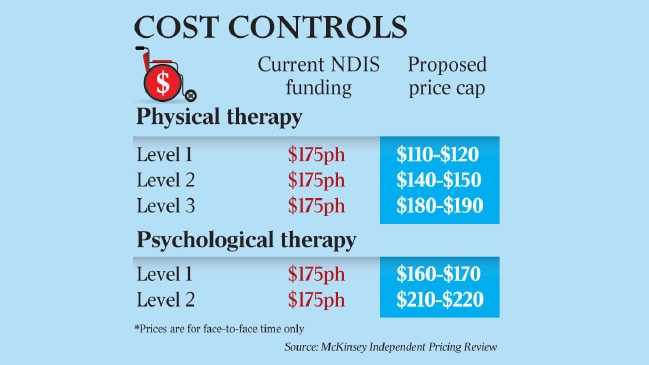‘Clear and present threat’: price caps risk NDIS revolt
Posted on
By Rick Morton
A battle worth hundreds of millions of dollars between therapists and the National Disability Insurance Agency represents a “clear and present threat” to the viability of the scheme as bureaucrats consider slashing prices paid for support by 40 per cent, sparking threats of a mass walkout by providers.
Despite spending $5 million on a consultant’s report to review pricing under the NDIS, agency bosses have gone “back to the drawing board” because some of the recommendations require “further detailed work or greater consultation” before they can be implemented.
The Australian understands the agency is concerned about “extreme” variability in charges for therapeutic supports across the country, with the cost of support the highest in Western Australia and South Australia.
While the agency moves to contain prices and set a “benchmark”, it also faces a blowout in costs it cannot control relating to other types of support as the Fair Work Commission considers changes to awards governing disability workers. Under the NDIS, the agency provides both the funding for support and sets price caps on what it will pay for those services. The existing price cap for all therapy support — including occupational therapy, speech pathology, physiotherapy and psychology — is $175 per hour but the McKinsey review recommended breaking this into three levels, with the bottom two ($110 and $140 an hour) below the current cap. “There should … be some savings from introducing tiered therapy pricing,” the review says.
The price caps affect any provider doing work with the vast majority of NDIS participants who do not “self-manage” their own funds. If a person manages their own support package, providers are not subject to price guides or caps.
In late March, Occupational Therapy Australia chief executive Rachel Norris wrote to the head of the NDIA, Rob De Luca, warning him the changes “threaten … the very viability of the NDIS”. “It is fair to say hundreds of service providers are poised to cancel their NDIA registration,” she wrote.
In a submission to a parliamentary inquiry into workforce issues and the NDIS, OTA says the “reluctance of many occupational therapists to commence or continue working with the agency is understandable”.
A spokeswoman for the NDIA said the Independent Pricing Review “undertook a detailed analysis of provider economics, market development and NDIA data and consulted widely”.
“While the NDIA has accepted in principle the IPR’s 25 recommendations, it asked McKinsey to re-examine therapy prices, after WA joined the scheme and following consultation with stakeholders, who also observed the relationship between complexity and therapy prices,” she said. “Until that work is completed, it would be premature to comment further on McKinsey’s initial recommendations.”
Before the NDIS, Amanda-Jane Reed was on the road with her then toddler son, Taj, for up to four hours a day to get to therapists’ rooms at opposite ends of Perth. At $190 for a 45-minute session with a speech therapist, and similar prices for physiotherapy and occupational therapy, Ms Reed was soon out of money.
“It did break me, I sold a block of land to pay for it,” she said.
Taj, now 12, has two therapy sessions a week that are fully covered. For Ms Reed, the possibility of losing access to therapists because of price caps is extremely stressful. Taj, who has cerebral palsy, autism and low vision, has defied predictions that he would never walk. In fact, he can now run. He can speak, which doctors told Ms Reed not to expect. He is learning numbers in his role as a scoreboard keeper at the University of Western Australia rugby club, and he likes to paint.
“He is not writing yet, but we haven’t given up,” Ms Reed said.
Her concerns at losing access to therapists are real. The Australian Physiotherapy Association’s Julie Dwyer said: “Many of our members have indicated that these changes would result in them deregistering as NDIA providers.”
Speech Pathology Australia said it had more than 680 members respond to a survey, two-thirds of whom said they would have to shut their businesses or stop seeing some or all NDIS clients if tiered pricing became a reality. “Only 13 per cent of respondents said that the new payment system would not impact their service provision,” chief executive Gail Mulcair said.
The therapy Taj undertakes is billed to the NDIS at a rate of $175 an hour, less than the $186 an hour that a member of the public would be charged for the same therapy but higher than most of the caps recommended by McKinsey.
“I cannot see the viability for quality therapy under the proposed tiered-fees arrangement,” Ms Reed said.
As part of its price review, McKinsey benchmarked the NDIS prices against other similar systems where therapists are service providers, such as Victoria’s Transport Accident Commission, Worksafe and the Department of Veterans Affairs, and found rates varied from $90 to $200 an hour. It used these benchmarks to propose the new pricing levels but provider groups say the analysis is flawed.
Under the DVA, for example, prices haven’t been increased in more than 10 years but therapists can charge for work that is done outside of a face-to-face session, unlike in the NDIS.
Therapists are involved heavily in supporting people with autism and, for speech therapists, those who have difficulty swallowing. But the broad theatre of their work covers multiple disabilities.
The NDIS, despite receiving disability money that once paid for swallowing support, plans to stop funding these services by pushing them back to state health systems and is developing a strategy to scale back the number of people with autism in the scheme.
The price the NDIA pays for support may be changed in other areas, too, with the Productivity Commission warning last year of threats to the scheme’s sustainability if the Fair Work Commission goes ahead with a proposed “casual conversion clause” for workers. “If these workers took up the option to convert to permanency … this could require adjustment to the assumptions used in the National Disability Insurance Agency’s pricing approach,” the October report says.

